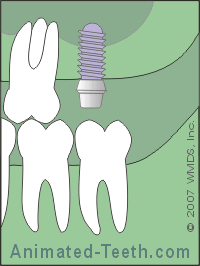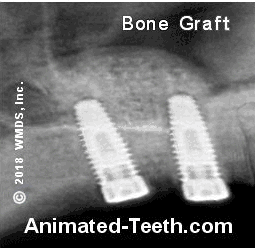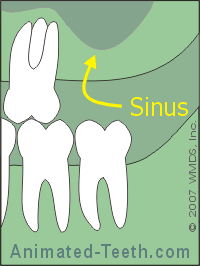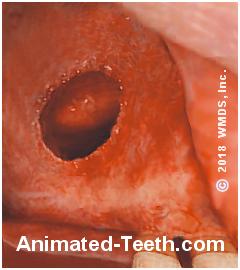The sinus lift procedure.
A) What is a Sinus Lift?
The “sinus lift” is a bone-grafting procedure that’s required when the volume of bone found in a patient’s upper jaw (in the region originally occupied by their bicuspid or molar teeth) is inadequate to accommodate the physical dimensions of a planned dental implant (length is usually the concern).
- While the need for this procedure is not uncommon, not all implants placed in a location previously occupied by upper molars or premolars will require it.
- It’s typically performed prior to implant placement surgery, so to allow time for bone healing (6 months or more). But with some cases, both a lift procedure and implant placement may be done at the same time.
Examples of when sinus-lift surgery is needed.
There can be several reasons why the volume of bone found in the posterior portion of a patient’s upper jaw might be insufficient to accommodate a dental implant. Some common ones include:

When there’s not enough bone for an implant, a sinus lift is needed.
- Normal sinus anatomy – It’s possible that the extent of the person’s maxillary sinus is just naturally comparatively large.
As such, its floor may dip down to a level that approximates the area of the roots of the patient’s upper molars and/or premolars (as shown in our illustration above).
- Bone resorption – This process refers to the loss of bone that naturally occurs over time following a tooth extraction. If enough time passes, the thickness of the bone in the region of the sinuses may be too thin to accommodate the length of an implant.
- Sinus pneumatization – This is a naturally occurring process where following a surgical procedure in the area of a sinus, its size increases due to the pressure it exerts (possibly related to the pressures of respiration) on the healing tissues. Continued enlargement may continue after bone healing has occurred.
- Other causes – Additional reasons include the removal of bone associated with previous surgical procedures (like a difficult tooth extraction). Or the loss of bone caused by periodontal (gum) disease.
We discuss all of these possibilities in greater detail on our implant placement bone evaluation page.

B) What does the sinus lift procedure accomplish?
- In our animation, the original (inadequate) thickness of bone is that which lies below the area outlined as the bone graft.
- As a result of the grafting procedure, enough bone now exists to encase the full length of two full-sized implants.
C) How is the sinus lift procedure performed?
The specific technique that a dentist uses can vary. But traditionally this surgery has been performed as follows:

A sinus lift increases the thickness of bone.
Lateral window technique.
- The dentist will make an incision in the patient’s gum tissue on the cheek side of their upper jaw in the region where the placement of the dental implant is planned. (This will be an area originally occupied by one of their upper bicuspid or molar teeth.)
After making the incision, the dentist will flap back the patient’s gum tissue and expose the surface of the jawbone that lies underneath.
- The exposed bone is cut in a fashion where a “trap door” of bone (hinged at the top) is created. This movable section of bone is then pushed gently inward and upward into the sinus cavity.
The bone movement will carry the sinus membrane (which is attached to it) along with it, thus “lifting” the membrane (and hence the sinus floor) to a new, higher level.
The empty space underneath the lifted sinus membrane is then packed with bone-grafting material (see below), thus providing the new bone into which a tooth implant can be placed.
- Once the bone-graft material has been positioned, the gum tissue flap is stitched back in place.
- In some instances, it can be possible that the dentist will place the dental implant at the same time that the sinus lift is performed.
In most cases, however, a dentist will allow a healing period of six to nine months before the dental implant is placed. The specific time frame allowed for healing is dependent upon the type of bone-graft material that has been used.

The bone graft materials are placed through the sinus window opening.
Other techniques.
Closed sinus lifts.
“Closed” procedures involve the placement of the bone graft material less invasively. For example, one method involves placing/pushing it through small holes drilled through the jawbone in the area directly adjacent to where the implant is placed.
An advantage of using a closed procedure is that the resulting wound is likely less extensive. And with some techniques, it’s possible that the implant itself may be placed during the same procedure. Both of these factors can reduce the amount of healing time or the number of surgeries needed for a patient’s case.
As a disadvantage, with some closed techniques only a limited amount of bone width/volume can be gained.
How much healing time is required?
Generally speaking, the amount of time allowed for bone graft healing lies on the order of 6 months, with a range of 4 to 8 months being common.
That means in cases where a sinus graft is performed first and then after healing has occurred the implant is placed, the patient’s total treatment process may encompass 9 months to a year until complete healing and osseointegration (fusion of the implant and bone) has occurred. (6 months for graft healing, 3 to 6 months for implant healing.)
Immediate implant placement.
In cases where the bone graft and implant placement procedures are performed during the same appointment, the graft’s healing and implant’s osseointegration will take place simultaneously, thus shortening the amount of treatment time needed for the completion of the patient’s case.
Factors and considerations.
Studies suggest that in cases involving sinus lift procedures, the amount of original bone thickness (height) needs to lie on the order of 4 to 5 mm (about 1/2 to 1/3 the length of the embedded implant). (Bortoluzzi)
That’s because this is the thickness of bone that will provide stability for the implant during its healing process. Implant stability is an important factor in its successful osseointegration (fusion with the surrounding bone).
So in cases where the amount of original bone is less than this amount, the treating dentist will most likely utilize a two-step process (sinus grafting first, then after healing, the implant is placed). If the amount of bone is greater, then it may be possible to perform both procedures at the same time.
▲ Section references – Bortoluzzi
What types of bone-graft materials are used with the sinus lift procedure?
Several different types of bone-grafting materials can be utilized with sinus lift surgery.
- The patient’s own bone may be used (autograft), such as that taken from another location in their mouth or else from other bones [including the hip (iliac crest) or shinbone (tibia)]. While the most difficult/inconvenient to obtain, this is considered the gold standard of grafting materials.
- Prepared bone (frozen bone, freeze-dried bone, demineralized freeze-dried bone) purchased from a tissue bank is a frequently used option. The grafting material source may either be from another human (an allograft) or another species (a xenograft, bovine tissue is often used).
- Another alternative involves the use of synthetically derived graft material (alloplast), such as hydroxyapatite.
What’s the success rate of implant sinus lift procedures?
In its discussion of this subject, a study by Yoon (2014) states that the reported survival rates for implant placement associated with sinus lift procedures range from 92 to 97%. (Success is generally judged by implant loss or detected mobility).
It’s important to state that there can be a host of factors involved with implant failure.
- In those cases involving sinus lift procedures, a lack of stabilization of immediately placed implants (discussed above) seems to be a common issue.
Another issue may be the type of bone grafting material used and its resistance to sinus pneumatization (discussed above). (Jeong 2014)
- However, for all implants, factors such as inadequate patient oral hygiene habits or a habit of smoking or bruxism (teeth clenching/grinding) may be the underlying cause.
Page references sources:
Bortoluzzi MC, et al. Comparative study of immediately inserted dental implants in sinus lift: 24 months of follow-up.
All reference sources for topic Dental Implants.
Comments.
This section contains comments submitted in previous years. Many have been edited so to limit their scope to subjects discussed on this page.
Comment –
Sinus graft implant together.
My dentist didn’t offer. Can I request that my implant is placed when my lift is performed so my treatment is quicker?
Jules
Reply –
Absolutely there’s no harm in asking but there may be reasons why doing so simply isn’t possible.
No doubt bottom line, you and your dentist want the same thing, a successful outcome. And right now it seems that your dentist is of the opinion that a two-stage approach makes the most predictable option. It’s true that techniques and further research are always evolving, so you should ask what’s possible. But as discussed above, it’s likely the thickness of your current bone in that area (and the lack of implant stability that it can likely provide) that has dictated their planned approach.
Staff Dentist
Comment –
Dental implant with upper sinus lift, next to root canal treated
Hi, 9 months ago I had a upper sinus lift with Dio implant where I had an extraction on 26, 27 had been a old root canal treatment, with amalgam filling, it had never been capped, now after the sinus lift and implant I’m due to go back for the abutment and porcelain crown to be fitted, but I’ve been experiencing for several months during the healing process of the upper sinus lift, a pain of sorts which feels like it’s coming from 27 canal treated tooth deep inside my gum, it seems to be there all the time it’s a throbbing dull pain, and constant, I went to my local dentist who X-ray the area, but could not see anything wrong with the tooth I’m thinking the pains coming from, there’s no hot or cold sensitivity on the tooth, only deep within my upper gum, jaw area, I’m worried as when I go back overseas to Budapest to have the work finished, that alls not right with what they did when they did the upper sinus lift, as I’ve also had a bad cough since having the upper sinus lift, any help would be greatly appreciated, thank you, in advance of your reply
James F.
Reply –
(For anyone reading, the tooth numbers stated are European nomenclature. Their USA equivalents are upper molars #14 and #15.)
As far as diagnosing your problem, we’re not going to be of any help at all. The obvious difficulty is that you have two adjacent sites, either of which might be the cause of your symptoms and hard to distinguish between.
As comparative worst-case scenarios, you might have failing root canal treatment (infected tooth) or a sinus or graft infection. (You mention a persistent cough, which is sometimes caused by persistent sinus drainage due to a sinus infection.)
But conceivably, even something as simple as teeth grinding (bruxism) could cause the symptoms you describe with your tooth.
You should be in touch with the dentist who placed the implant. They might request that you have some type of radiograph taken that could be forwarded to them so to help them pass judgment on their work.
Staff Dentist